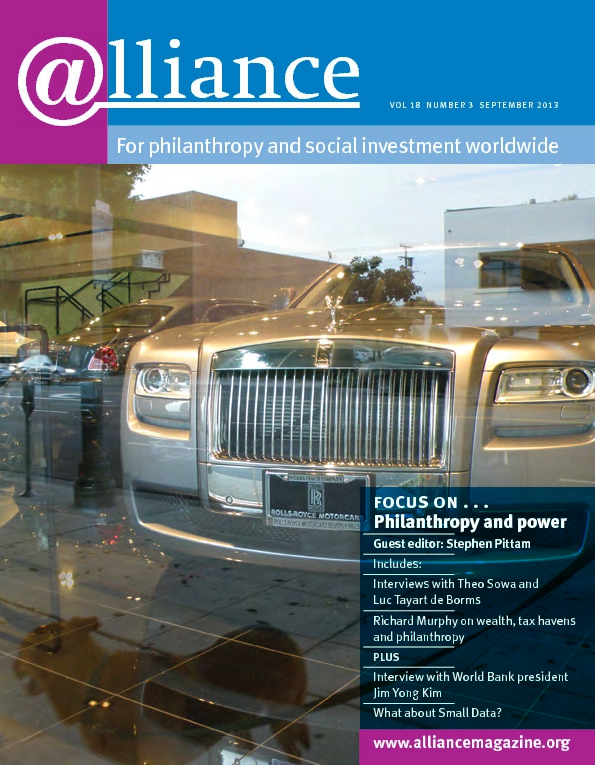‘Let not thy will roar, when thy power can but whisper.’
Dr Thomas Fuller
Wealthy donors are typically the lifeblood of a community foundation. These individuals and families draw their power from many of the institutions that define contemporary life in a capitalist society – not only financial institutions, but also the many laws, policies, electoral arrangements and even networks of formal and informal relationships that enable wealth to perpetuate wealth. It’s no wonder, then, that the affluent (and I include myself in this class) often want to preserve the status quo. Residents of low-income communities, by contrast, are far less eager to leave things as they are. From their perspective, what’s needed goes beyond a few changes around the margins. Society must shift in fundamental ways for justice to prevail.
 The staff of a community foundation are typically poised between these two camps.[1] We honour the generosity of donors who selflessly share their wealth with the less fortunate, while also acknowledging the legitimacy of claims made by the poor. The dilemma in this case can be resolved in any number of ways, ranging from a slow evolution towards social, economic and political arrangements that are more just to an uncontrolled militancy on the part of the poor. In the most extreme case, the marginalized will exercise their power of ‘nothing left to lose’.
The staff of a community foundation are typically poised between these two camps.[1] We honour the generosity of donors who selflessly share their wealth with the less fortunate, while also acknowledging the legitimacy of claims made by the poor. The dilemma in this case can be resolved in any number of ways, ranging from a slow evolution towards social, economic and political arrangements that are more just to an uncontrolled militancy on the part of the poor. In the most extreme case, the marginalized will exercise their power of ‘nothing left to lose’.
In a country like the US, where we often confuse power with greatness, grantmakers seldom analyse the dynamics and effects of power. Some of our advocacy organizations take part in exercises called ‘power mappings’, tracing the lines of access and influence in a legislative campaign, for example. A more general analysis of how wealth and its brethren subvert American democracy still evades us, however. And so, just a few years after the great financial meltdown of 2008, we find bank lobbyists ‘not leaving it to lawmakers to draft legislation that softens financial regulations. Instead, the lobbyists are helping to write it themselves.’[2]
The exercise of power by elites in a small city like New Orleans leaves many traces. It will be interesting to see whose account of the recovery from the storms of 2005 ultimately gains traction in the imagination of the broader public. One set of narratives, drawn from the mainstream press and re-published with great vigour by local economic development organizations, portrays the city of New Orleans as a kind of ‘comeback kid’, safeguarded by new and stronger levees against the ravages of nature; a magnet for young entrepreneurs; a good place to raise one’s children. Louisiana’s citizens pay the fourth lowest overall tax bill as a percentage of income, and public school test scores have been improving. The city is open for business.
Another set of narratives acknowledges the gains but pays special attention to what has conspicuously not changed since 2005. In the Louisiana Weekly, the city’s only black-owned newspaper, the New Orleans story is still largely a tale of two cities. Despite all the investments in the Gulf South since Katrina, the inequities surfaced by the storms of 2005 persist to this day. In fact, many have deepened. (Pictured: an empty street in Lower Ninth Ward three years after Katrina. Photo by Rain Rainu.)
There is ample evidence to support the view that New Orleans is indeed the City that Care Forgot. Last June, the Joint Center for Political and Economic Studies, alongside the Orleans Parish Place Matters team, published a report titled Place Matters for Health in Orleans Parish. Among its key findings was that the average life expectancy in Orleans Parish varies by as much as 25 years depending on a person’s residential postal code, and that the postal codes with the lowest life expectancy had a higher population of low-income people and people of colour. The poorest postal code in the city, with a majority population of African Americans, had an average life expectancy of 55, as opposed to 80 in a postal code with far less poverty and a mostly white population. Another report from the Greater New Orleans Community Data Center finds that, among other things, 48 per cent of black children in Orleans Parish live in poverty, defined as an income of about $18,000 supporting a family of two adults and a child. Most recently a study commissioned by the Lindy Boggs National Center for Community Literacy reported that 52 per cent of African American men (aged 16-64) in New Orleans are either unemployed or not in the labour force.
As a community foundation that aims to serve as a kind of bridge between rich and poor, black and white, we face two competing narratives about life in contemporary New Orleans. One draws its inspiration from the chamber of commerce. The other insists that we remember the chamber of horrors still experienced by many of our citizens, especially our black men, 1.5 million of whom across the country, out of a total voting population of 10.4 million, have lost their right to vote due to felony convictions; and one in three of whom between the ages of 20 and 29 is under correctional supervision or control. It may be, as Sylvia Ashton-Warner once said, that ‘truth has beauty, power and necessity’. But how fragile that power so often appears to be! In just about every domain of consequence to the health of our evolving democracy – in our media, our political life, the work of our foundations and NGOs – truth is often the first casualty, trodden upon by forces that appear to be much more powerful, at least in the short term.
What power does a community foundation have?
A key question for a community foundation is what role, if any, it will play in social transformation, for it too, like the central actors in the simplistic sketches I’ve just given, has powers peculiar to its station. To begin with, a community foundation has the power of perspective. Understanding in a holistic way what happens in a community – how its various parts fit together and interact – is essential to its effectiveness. It acquires this perspective (or should) by working in close partnership with all sectors of society. Thanks to the generosity of its many donors, a community foundation also has the power of the purse, the ability to marshal significant resources for the common good. Finally, it has the power of persuasion, using its voice and its ability to gather stakeholders to help settle disagreements and advance progressive agendas.
How can these powers be used?
At a very practical level, how might these various powers be deployed? I offer the reader some suggestions drawn from our own experience in New Orleans, fully aware that context is everything.
Trustee ownership of the conversation
Typical of many community foundations in the US, the Greater New Orleans Foundation has a staff whose worldviews run markedly to the left of those held by trustees.[3] But in order for trustees and staff to work effectively in the socioeconomic borderlands, we need to diminish the psychic dissonance between us. This requires strong and sensitive board leadership, supported by trustees willing to take risks. These risks include broaching difficult subjects such as race and class, and trying to find a language that can unite all in common purpose.
Board diversity
If people of colour comprise 60 per cent of the population you’re serving, don’t let them constitute just 10 per cent of your board. Numbers do matter, as well as the positions of responsibility occupied by diverse trustees. People of colour currently constitute close to half of our foundation’s trustees. This composition closely reflects the racial and ethnic composition of our community and helps ensure that key perspectives are represented – and supported – in our deliberations.
Stick to your knitting
In conversations with our trustees, we learned that many ideological clashes could be avoided if staff members stuck to matters of fact, to an objective description of the challenges at hand. Editorializing on the issues, assigning blame, or practising sociology without a licence quickly met with resistance and threatened to derail social change efforts. Progress required that staff leave the liberal echo chambers they were so accustomed to inhabiting.
Don’t elide difficult subjects
While race is a divisive topic in New Orleans, there’s also clear evidence that racism in its many forms continues to drive the disparities we see in south-eastern Louisiana. We can’t go around it, so somehow we need to go through it. This is one of our toughest challenges, given that traditional ways of talking about race – for example, in the context of trainings on cultural competency – are almost universally detested. We’re always on the lookout for creative, non-threatening and transformative ways to address this issue.
Metrics and evaluation
These are your friends, not your enemy. Many grantmakers in the social justice camp shrink from the idea that cold numbers and data can fuel social change. Our own experience has been that these data keep us honest about our shortcomings and challenge us to improve our work. The data clearly indicate that grantmaking as usual will not help solve our most deeply entrenched problems.
No doubt some community foundations will eschew thorny social issues. They might choose to do little more than perpetuate themselves as institutions, or play a largely palliative role in addressing the ills of a given region. At their best, however, they can use their powers to help move earth a little closer to heaven.
1 See eg Albert Ruesga, ‘The Foundation as Borderland Institution’. http://postcards.typepad.com/white_telephone/2012/07/borderland-institution.html
2 See eg Eric Lipton and Ben Protess, ‘Banks’ Lobbyists Help in Drafting Financial Bills’. http://dealbook.nytimes.com/2013/05/23/banks-lobbyists-help-in-drafting-financial-bills/?_r=0
3 Cf ‘The Big Uneasy: New data on community foundations and social justice’. http://postcards.typepad.com/white_telephone/2011/11/biguneasy.html
Albert Ruesga is president and CEO of Greater New Orleans Foundation. Email albert@gnof.org






Comments (0)